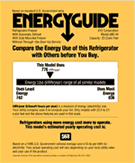DVD Players & Combination Units
Get Rebates,
Incentives & Services
Introduction
As the amount of television-related equipment per household increases nationwide, so does the amount of standby energy use. Standby electricity is energy consumed by appliances when they are switched off or not actively performing. DVD players and combination units account for the greatest portion of standby electricity use in the home, approximately 35% of all standby power consumed.
A TV-DVD-VCR combination unit is a system that combines a television, DVD player and VCR into a single unit that plug into an outlet with a common cord. Combination units bearing the ENERGY STAR logo use 35% less energy than standard units, and approved DVD players use as little as one quarter of the energy of standard models.
Technology Options
DVD PlayersIn addition to energy performance, there are other important operating and convenience features to consider when shopping for DVD players.
- Single vs. Multiple Disc: Single disc players hold only one disc, requiring you to manually change one in order to listen to or watch another. Multiple disc players commonly hold around 5 discs in a carousel. DVD players are available that hold large numbers of DVDs and CDs, eliminating the need to store discs separately.
- Multiple Format Capabilities: Many DVD and CD players also can play home-recorded CDs on CD-R (recordable) or CD-RW (rewritable) discs or MP-3 formats. Be sure to understand which formats a particular DVD player can play back.
- Progressive Scan: A DVD player must decode the data on the disc in order to access the image, which is done by either progressive or interlaced scanning. Standard analog screens decode the odd field and then the even field, pairing both fields together to create one frame every 60th of a second. A progressive scan signal decodes the lines successively, creating 60 complete fields and frames per second and producing a noticeably clearer, sharper picture. You must have a digital TV to benefit from the advantages of progressive scan.
In combination units, the TV and DVD/VCR are combined into one appliance, and a common cord is shared to power them all. Combination units therefore save space, simplify set up as they require fewer cables, are more portable, use fewer remotes and generally consume less energy in standby mode than separate components. Combination units come in three different models: TV-VCR, TV-DVD and TV-DVD-VCR. For more information on the most energy efficient televisions, view our televisions product guide.
Efficiency Benefits
Today, energy consumption from DVD players, TVs and related products accounts for 10% of the average household’s electricity bill. If all DVD players and combination units were ENERGY STAR qualified, it would cut greenhouse gas emissions by 6 billion pounds, the equivalent of taking 75,000 cars off the road.
An ENERGY STAR qualified combination unit uses around 35% less energy than standard models. Due to their minimal number of cords, combination units generally use less energy than separate TV, VCR and DVD players when on standby. In addition to saving you money, many ENERGY STAR qualified DVD players and combination units also come with all the latest features like progressive scan.
Manufacturers
Panasonic and Wimco offer energy efficient models. For a complete list of ENERGY STAR qualified DVD Players and Combination Units, visit the ENERGY STAR web site.
Purchasing Tips
|
||











